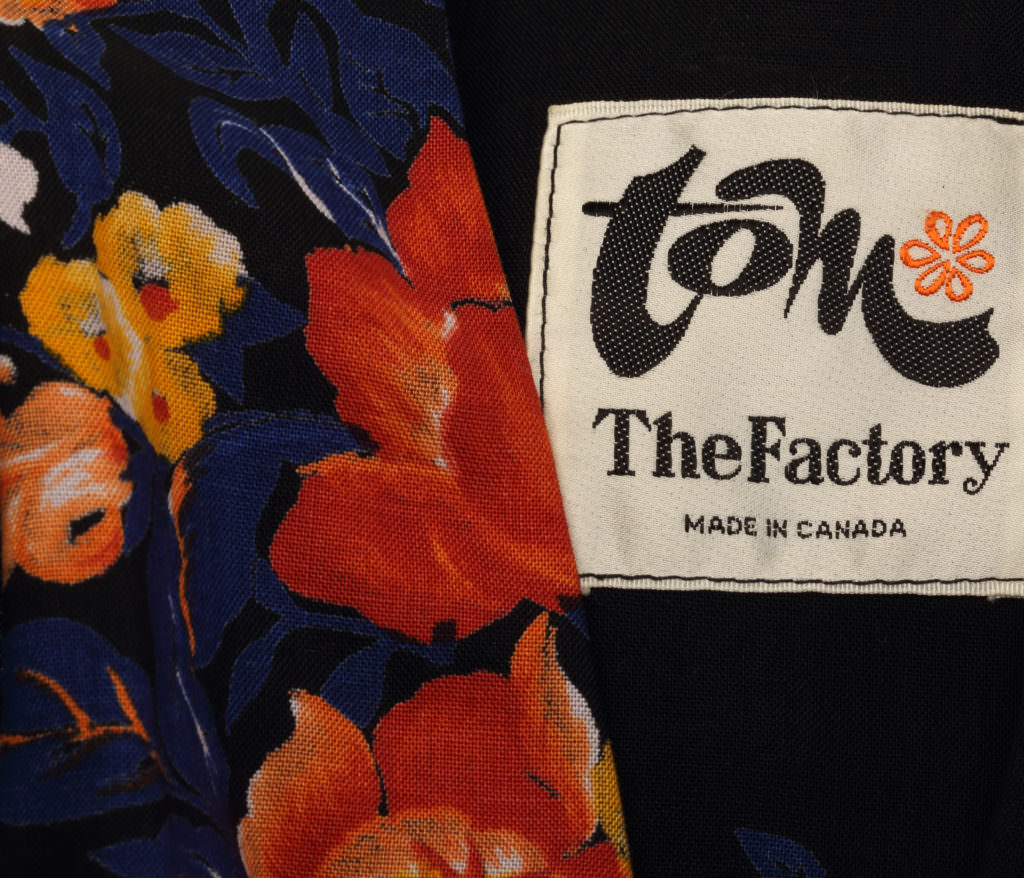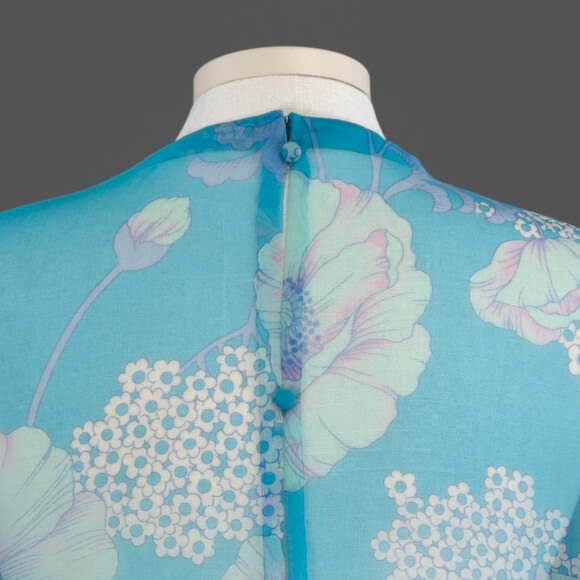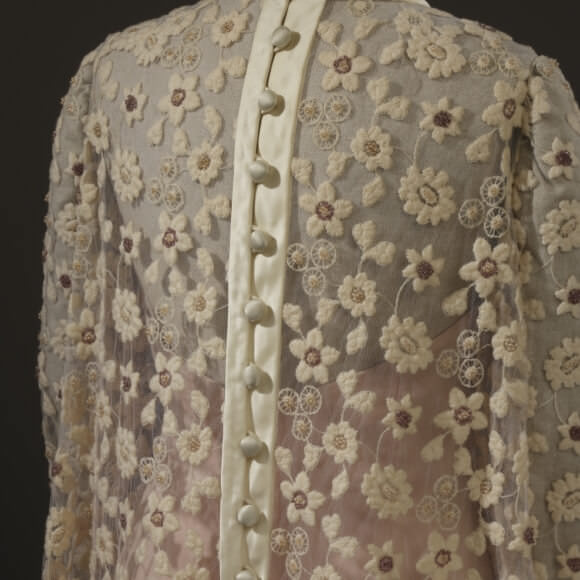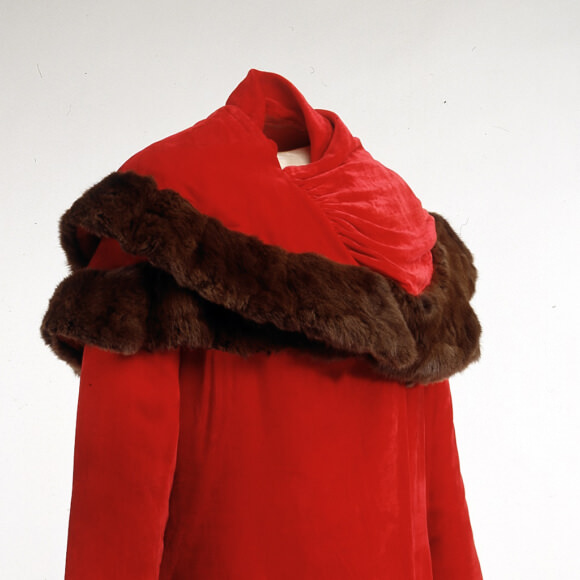
Pants (details), Tom D'Auria, about 1972. Gift of Tom D'Auria, M972.102.2 © McCord Museum
Thomas D’Auria arrived in Montreal in 1970 after graduating from the fashion apparel design program at New York’s Fashion Institute of Technology and working for four years as an assistant in a number of Seventh Avenue design studios, including those of Pauline Trigère and Geoffrey Beene.
D’Auria’s first job in Montreal was for the children’s wear manufacturer Tam O’Shanter, located at 9250 Park Ave. In 1971, The Factory hired him to inaugurate a sportswear line, under the label Tom for The Factory. The press referred to it as being “for the young sophisticate who likes and wants to be noticed but not in an outrageous way,” and “one of Montreal’s hippest ready-to-wear resources,” noting his classic, 1950s-inspired shapes and playful use of colour. In 1972, his collection was featured in Montreal Mode, the first of a series of annual shows to which 100 North American buyers and media representatives were invited.
As he developed name recognition in the Montreal fashion business, D’Auria was hired in a freelance capacity by a number of other Montreal-manufactured lines, including Patricia Silkwear, Celanese, and Modes Bilboquet. He often found himself running between suppliers and factories on St. Lawrence and the Chabanel garment district.
During this time, D’Auria was part of an active cohort of young designers in Montreal, including Leo Chevalier and Michel Robichaud, who came together to form the Fashion Designers Association of Canada. The goal of this body was to promote Canadian-made fashion at home and abroad, maintain high standards across the industry, and develop young talent. Founded in 1974, the group consisted of designers from Montreal, Toronto, and Vancouver, who joined upon invitation by existing members. D’Auria spoke enthusiastically about the group’s potential to gain international recognition and protect designers from exploitation.
D’Auria participated in many FDAC-organized events throughout the 1970s, such as the Canadian Designer Showcase that toured 19 cities in the spring of 1976, where he presented designs for both Bilboquet and Patricia Silkwear lingerie.
The group’s first gala event was held in 1977 at the Four Seasons, featuring a fashion show of men’s, women’s, and children’s wear, from which Tom D’Auria’s blouson dress with a bare back was singled out as “the sexiest thing to turn around on any runway.”
D’Auria left Montreal for Toronto in 1978, taking a job at Mr. Leonard, a high-volume sportswear manufacturer. Mr. Leonard then produced D’Auria’s first eponymous line of sportswear. Here he developed his career-long focus on wearability and adaptability, designing garments that could go from sporty by day to glamourous by night. The clothes were sold in Eaton’s, Simpson’s, Holt Renfrew, and Your Choice boutiques across Canada. When that line was closed in early 1983, D’Auria teamed up with manufacturer D&S Dressworks to release an independent line under his own name, the first season of which showed simple one- and two-piece dresses in fabrics such as faille and velvet, intended for the growing market of professional women. He maintained a focus on value, keeping prices relatively low and utility high, stressing the office-to-evening transition.

Pants (details), Tom D’Auria, about 1972. Gift of Tom D’Auria, M972.102.2 © McCord Museum
His business grew throughout the 1980s, expanding to the US and UK markets by 1987, where his clothing was sold in Macy’s, I. Magnin, Casual Corner and Harrod’s. D’Auria continued to participate in many events and outreach initiatives designed to raise the profile of the Canadian fashion industry, including the Special Moments touring fashion show in the mid-1980s and the Festival of Canadian Fashion in 1988, even designing three consecutive gowns for Miss Canada representatives at the Miss Universe pageant in the mid-1980s.
In September 1987, his work was featured in a 12-page ad supplement run in Vogue and Women’s Wear Daily titled Canadian Chic and sponsored by Fashion Canada, a federal government program run by External Affairs, as well as four provincial governments.
In 1989, following some difficulty both within his company and in the larger Canadian apparel market, D’Auria closed his business and moved back to the United States with his family, where he designed lingerie for August Silk before taking a job as design director with Jones New York, where he remained for nine years. Soon after, he began work at Nygard International, a Canadian company operating out of New York, and was design director for their top line for 19 years before retiring in 2017. Since retiring, he occasionally lectures at fashion schools and works as a consultant in the fashion industry.
Sources
“Canadian designer creations coming,” Ottawa Citizen, 5 September 1985.
Carter, Joyce, “Cities to see spectrum of top designers’ work,” The Globe and Mail, The Globe and Mail Inc., 2 April 1976.
Carter, Joyce. “Waists Wander for a New Viewpoint,” The Globe and Mail, The Globe and Mail Inc., 30 June 1987.
D’Auria, Thomas. Interview, 16 January 2019.
Dollery, Eveleen. “Canadian designers make it on the international scene,” Chatelaine, Les Éditions Rogers limitée, September 1972.
Gall, Nancy. “Evening wear designer shows work in Toronto,” Ottawa Citizen, 23 April 1987.
Hess, Jane. “Designer launches label with classy fall line,” Toronto Star, Torstar, 28 May 1981.
Ludlum, Judy, “Uniontown Talent Shines Bright in Montreal Mode,” Pittsburgh Post, Block Communications, 6 July 1972, p. 10.
Morra, Bernadette. “D’Auria’s dresses offer fashion savvy,” Toronto Star, Torstar, 6 August 1987.
Rider, Wini. “Design group to boost fashion status,” The Gazette, Postmedia Network, 15 May 1974.
Publication date
01/10/2004
Writing
Dicomode
Revision
Laura Snelgrove, Contributor
Share
DownloadRecommended entries
© MCCORD STEWART MUSEUM 2025






